
views
Building the Pit

Make a bed for the coals. Find an out of the way place where you can fashion a bed of coals that will serve as the roasting pit. A flat, open space will work best. For best results, dig a shallow ditch and fill or ring it with gravel or flat stones of a uniform size, allowing space in the center for the wood you'll be burning to produce the coals. You also have the option of simply lining a flat patch of ground with stones and then burning off the wood. If you don’t have a lot of space to work with, or have no desire to start a fire directly in your backyard, consider using a metal clamshell grill to burn the wood. Setting up a roasting pit on flat ground may damage any vegetation growing underneath the area where you lay out the stones.
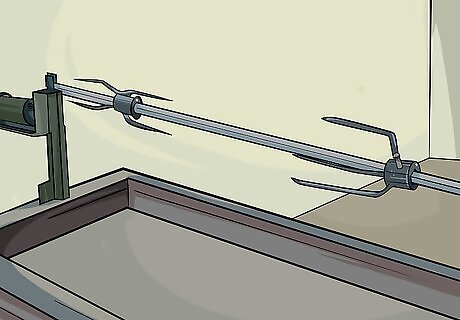
Place supports at the head and foot of the pit. Whether you’re assembling a store-bought roasting spit or cobbling together your own, you need to have a way to hold the pig over the heat once it’s time to get cooking. Situate these support materials on either side of the pit lengthwise. Some people have success simply using ‘Y’-shaped sticks which hold the spit in their crooks. Others prefer to construct more elaborate setups using spare lumber or well-spaced cinderblocks. As long as the supports you build will hold the weight of pig and spit, they’ll work just fine. When using wooden supports, make sure to drive them into the ground partially so that they’ll be firmly rooted. Whatever you decide to use as your supports, they should be tall enough to hold the spit 1-2 feet (.30-.60m) over the pit.
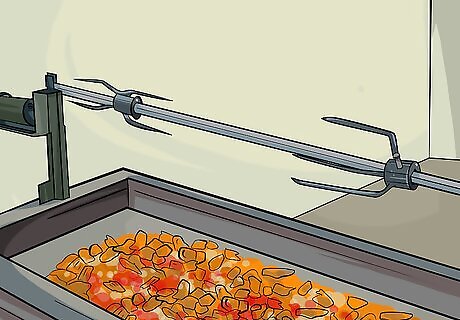
Start a fire that you’ll use for cooking. Traditionally, slow roasting of this type is done using wood coals. Gather the wood you’ll be using to start the fire. Most people prefer to use basic types of wood that burn clean, like hardwood, or varieties like applewood that add flavor to the meat with their smoke. Arrange the firewood on top of the stones in the pit in tight clusters. Get a fire going and wait for it to consume the wood and die down until only glowing coals remain. Wood coals burn at very high temperatures for a long duration. Their constant heat will roast the pig to perfection. You will likely require 5 or more bundles of wood to have enough to spread out over the surface of the pit. You can supplement the wood coals with bagged charcoal if you choose. This will keep the pit burning longer and make the heat more consistent. However, charcoal doesn't burn as clean as wood coals, and may influence the flavor of the meat. Roasting a whole pig is an all day event. Cooking an average size pig of 75-100 pounds (34-45kg) will take the better part of twelve hours.
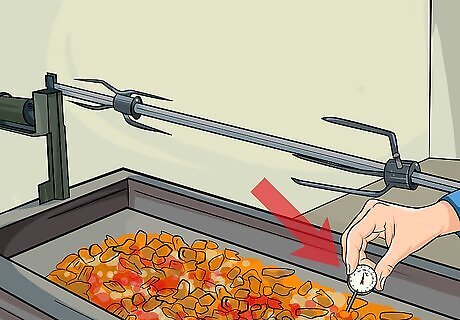
Bring the coals to the right temperature. Most experienced culinary veterans recommend around 250 degrees Fahrenheit (121 degrees Celsius) as the optimum temperature for a slow-roast. The pit needs to be kept hot enough for the heat of the coals to penetrate into the meat of the pig, but not so hot that it cooks unevenly or too fast. The coals will need to be raked and repositioned as the pig roasts to keep cooking temperatures even, and more wood may need to be added when the pit begins to lose heat. Test the temperature of the pit by holding up a culinary thermometer at about the point where the pig will be suspended. Cooking temperatures do not have to be exact, as how quickly and evenly a pig will get done depends largely on its size, thickness and positioning. Aim for 225-250°F (107-121°C) as a rough guideline. Any cooler than that will take much longer.
Preparing the Pig
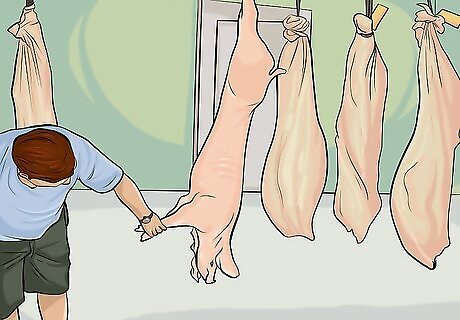
Get a pig that has already been dressed. Buy your pig from a farm supplier or butcher. If possible, have the butcher "dress" the pig and remove the organs and troublesome accessory tissues before taking it home. The pig’s internal cavity should be totally empty to better conduct heat, or to allow you to stuff it should you so desire. You may be able to save a few bucks dressing it yourself, but it will add greatly to your workload. Pigs come in different weights and sizes. Obviously, the larger the pig, the longer it will take to cook. If you don’t have all day to spend slow roasting, or aren’t feeding as many people, think about buying a small suckling pig. Ask your butcher about the means to transport the pig home. They will often be able to supply zip-up bags that will keep juices from getting all over your car and prevent the meat from being exposed to the open air. If you’ve bought a whole frozen pig, it will need to be thawed before it can be cooked. To thaw a frozen pig carcass, submerge it in a light ice bath and allow it to warm gradually as the ice melts. This can take several days if the pig is large enough.
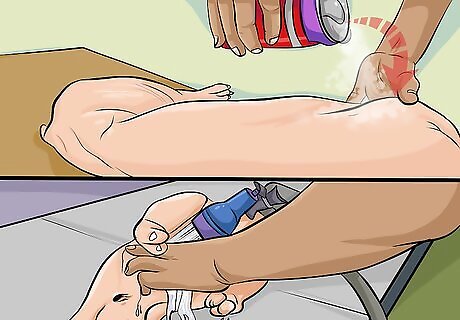
Clean the pig and rub it down with salt. Pig carcasses are often covered in dirt, feces and bacteria, so it will be necessary to clean the pig before cooking it. Wipe down the pig’s extremities and any incisions or openings made by the butcher with a cold, wet towel. If you’re working outside, spraying the pig off with a hose can cut down on your prep time. Sprinkle the carcass liberally with coarse salt and massage it into the skin. Do the same for the inner cavity. The pig will need a good wiping down even if it has already been cleaned by the butcher shop where you bought it. Salt not only works as a seasoning but has antimicrobial properties which can kill lingering germs.
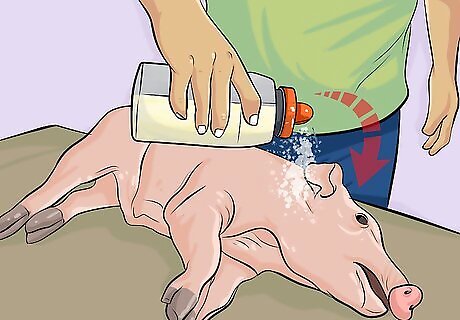
Add other spices, brines or marinades. At this point, you can season the pig further, if you wish. Additional spices such as black pepper, cayenne, turmeric, paprika or seasoned salt can be rubbed into the skin, or you might inject a strong marinade or brine underneath the skin using a meat injector. This will impart extra flavor to the pig as it cooks. Don’t forget to zest up the pig’s inner cavity as well, if it’s accessible by hand. Try working a specially blended dry rub into the skin prior to cooking. Injecting brines and marinades into the meat will add moisture to keep it from burning and make it especially tasty once it’s done.
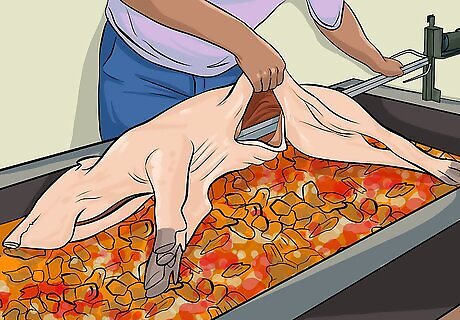
Secure the pig to a spit. To successfully roast the pig over open heat, it will need to be affixed to a spit—a long, straight pole that runs through a piece of meat being cooked whole. Spits are large, pricey and somewhat unwieldy, and aren’t the kind of thing most people have lying around in their homes, but they can sometimes be rented from farms or traditional barbecue suppliers. You can also purchase a sturdy metal rotisserie to get the job done, or fashion your own out of stripped and whittled wood if you’re feeling crafty. Guide the spit carefully through the anus or rear opening of the pig and out through the mouth. This may be a 2-3 man job. The spit should be long enough to lay atop the supports at either end of the fire and strong enough to support a pig up to or over 100 pounds (45kg). Tie the pig’s legs and midsection to the spit using wire or twine to keep it from sagging and flopping around as it hangs over the coals.
Roasting the Pig
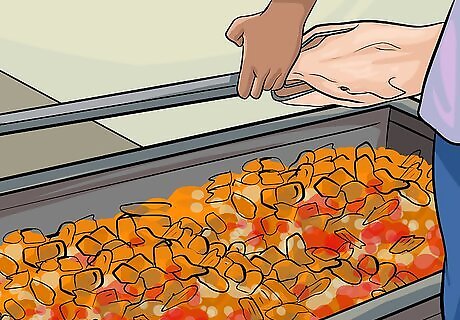
Hoist the pig onto the supports on either side of the pit. Once the pig has been secured to the spit, lift and place it on the supports to rest it over the pit. The pig should be centered and suspended roughly 1-2 feet (.30-.60m) above the coals. Any closer and the heat may cause the skin to scorch. Make sure the spit doesn’t slide or move around after it’s been mounted. Make sure you have help getting the pig positioned over the coals. They can be heavy!
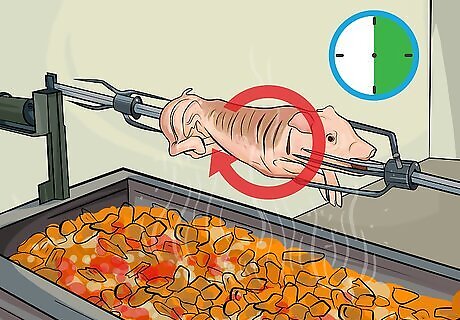
Allow the pig to cook for several hours on both sides. Let the pig cook at a moderate distance from the coals. One helpful guideline to keep in mind is that the pig should cook one hour for every ten pounds of its weight; for a pig of average size, 75-100 pounds (34-45kg), this means 4-6 hours on each side. Sit back and enjoy a cold beverage in the meantime! At the halfway point, turn the pig over to begin cooking the opposite side. Remember to keep the pit hot by adding more wood provisionally, and rake and reposition the coals if any one part of the pig is cooking faster than another. ”Slow and low” is what experts recommend when roasting a whole pig. It’s time consuming and demands constant attention, but makes a great centerpiece for a day of cooking and socializing. Brush on a coating of barbecue sauce, or use a turkey baster to drench the pig in a savory marinade as it cooks. This will ratchet up the flavor and keep the skin crisp and juicy.
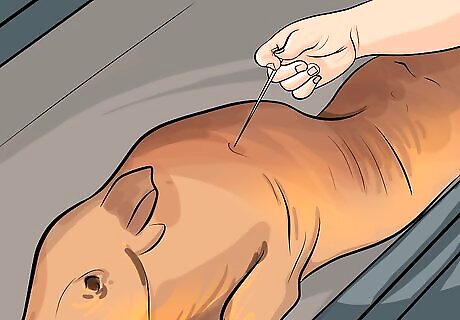
Take the pig’s temperature in multiple spots. When the pig is nearing completion, its skin will begin to brown and bubble, but there’s no way to tell if the meat inside is done except to temp it. Use a professional-grade meat thermometer to take an internal temperature reading in different areas of the pig. The soft belly and bacon sections (the fatty tissue on the backside) are best served at around 145°F (63°C), while tougher, more sinewy parts like the shoulder and haunches will need to be at least 160-165°F (74°C) before they’re safe to eat. You will need to take a temperature reading several times throughout the cooking process. Do not serve the pig if any part of the meat is below 145°F (63°C). If an area is particularly slow getting done, reposition the coals underneath that area to increase the heat.
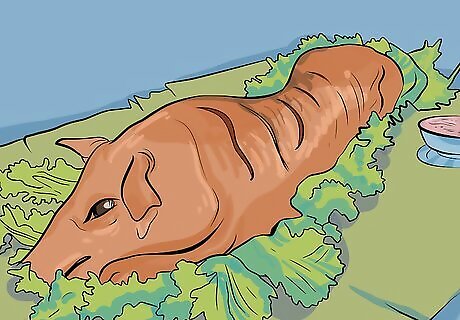
Carve and serve the roast. After 10-12 hours the pig is now a crispy brown and the internal temperature is right—it’s time to eat! Take the pig off the coals, remove the spit and tell everybody to dig in. You can either carve the roast up into sections, dice it all together like pulled-pork barbecue or have everyone tear off their favorite sections by hand. When cooked right, the meat should be tender enough to pull apart. Slather the roast pork in your favorite sauce, serve it with a few sumptuous sides and enjoy! The meat should be juicy when fully cooked, but not bloody or red. If it isn’t quite done enough when you cut into it, it may need a few more minutes. Pair a roasted pig with other backyard cookout favorites like grilled veggies and baked beans, or go for the more island-inspired flavors of wild rice, fried plantains and pineapple.

















Comments
0 comment